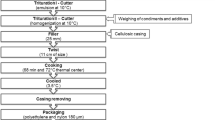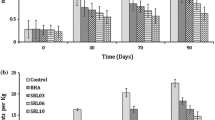Abstract
The sensory intensity measured as theabsolute threshold value of spice andrecognition of spice was evaluated for summer savory and rosemary in meat balls. The values forabsolute threshold value of spice were found to be significantly lower for rosemary than for summer savory. The antioxidative activity of the spices was analysed in two accelerated model systems and in a storage experiment. In one of the model systems, oxidation was accelerated by heat and by an elevated pressure of oxygen. Both spices significantly improved the oxidative stability of the meat balls in this model system. In the second model system metal catalyst oxidation in a meat slurry was used and a reduction in the oxidative processes in samples containing the spices was again shown. In both model systems a slightly higher antioxidative activity was seen for rosemary compared to summer savory. In the storage experiment, the spices were added at a sensorially acceptable level and the heat-treated meat balls were stored at 5°C. A significant reduction in the development of warmed-over flavour (WOF) caused by the addition of spices was measured by a reduction in 2-thiobarbituricacid-reactivesubstances (TBARS) and in hexanal. A reduction in TBARS of approximately 30% in meat balls containing added spices was seen independently of packaging in 1% oxygen or in atmospheric air and the reduction (30%) was constant throughout the storage period.
Similar content being viewed by others
References
Lechowich RV (1988) Food Technol 42: 84–85, 89
Mielche MM, Bertelsen G (1993) Z Lebensm Unters Forsch 197: 8–13
Igene JO, Pearson AM (1979) J Food Sci 44: 1285–1290
Wilson BR, Pearson AM, Shorland FB (1976) J Agric Food Chem 24: 7–11
Mielche MM (1995) Z Lebensm Unters Forsch 200: 186–189
Huisman M, Madsen HL, Skibsted LH, Bertelsen G (1994) Z Lebensm Unters Forsch 198: 57–59
Bailey ME (1988) Food Technol 42: 123–126
Chipault JR, Mizuno GR, Lundberg WO (1956) Food Technol 10: 209–211
Madsen HL, Bertelsen G (1995) Trends Food Sci Technol 6: 271–277
McNeil JH, Dimick PS, Mast MG (1973) J Food Sci 38: 1080–1081
Korczak J, Flaczyk E, Zdzislaw P (1988) Fleischwirtschaft 68: 64–66
Vyncke W (1975) Fette Seifen Anstrichm 77: 239–240
Shahidi F, Pegg RB (1994) J Food Lipids 1: 177–186
Meilgaard M, Civille GV, Carr BT (1991) Sensory evaluation techniques, 2nd edn. CRC, Boca Raton, Fla, pp 123–133
Morgan BJT (1992) Analysis of quantal response data. Chapman and Hall, London
Statistical Sciences (1991) S-Splus User's Manual vol 2, StatSci Europe, Oxford
Nolan NL, Bovers JA. Kropf DH (1989) J Food Sci 54: 846–849
McDonald B, Gray JI, Kakuda Y, Lee MI (1980) J Food Sci 45: 889–892
Frankel EN (1993) Trends Food Sci Technol 4: 220–225
Stapelfeldt H, Bjørn H, Skovgård IM, Skibsted LH, Bertelsen G (1992) Z Lebensm Unters Forsch 195: 203–208
Lai S-M, Gray JI, Smith DM, Booren AM, Crackel RL, Buckley DJ (1991) J Food Sci 56: 616–620
Resurreccion AVA, Reynolds AEJ (1990) J Food Sci 55: 629–631,654
St. Angelo AJ, Crippen KL, Dupuy HP, James CJ (1990) J Food Sci 55: 1501–1505
Madsen HL, Nielsen BR, Bertelsen G, Skibsted LH (1996) Food Chemistry (in press)
Chipault JR, Mizuno GR, Lundberg WO (1955) Food Res 20: 443–448
Herrmann K (1962) Z Lebensm Unters Forsch 116: 224–229
Bertelsen G, Christophersen C, Nielsen PH, Madsen HL, Stadel P (1995) J Agric Food Chem 43: 1272–1275
Cuvelier M-E, Richard H, Berset C (1992) Biosci Biotechnol Biochem 56: 324–325
Brand-Williams W, Cuvelier M-E, Berset C (1995) Lebensm Wiss Technol 28: 25–30
Author information
Authors and Affiliations
Rights and permissions
About this article
Cite this article
Madsen, H.L., Andersen, L., Christiansen, L. et al. Antioxidative activity of summer savory (Satureja hortensis L.) and rosemary (Rosmarinus officinalis L.) in minced, cooked pork meat. Z Lebensm Unters Forch 203, 333–338 (1996). https://doi.org/10.1007/BF01231071
Received:
Revised:
Issue Date:
DOI: https://doi.org/10.1007/BF01231071




